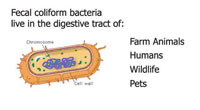
What are Bacteria?
Bacteria are single-celled organisms that live in and around us. They can be either free-living or parasitic and some cause illness in humans and/or animals.
What are Fecal Coliform Bacteria?
Bacteria of the coliform group are often used to assess water quality. They are considered primary indicators of fecal contamination and disease bacteria in the water.
Fecal coliforms (FC) are bacteria that live in the digestive tract of warm-blooded animals (humans, pets, farm animals, and wildlife) and are excreted in the feces. In themselves, fecal coliforms generally do not pose a danger to people or animals but they indicate the presence of other disease-causing bacteria, such as those that cause typhoid, dysentery, hepatitis A, and cholera.
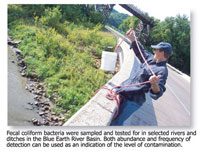
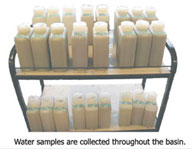
Monitoring for Bacteria
Fecal coliform bacteria were sampled and tested for in selected rivers and ditches in the Blue Earth River Basin. Both abundance and frequency of detection can be used as an indication of the level of contamination.

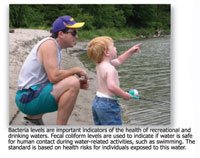
Why should we be concerned?
Bacteria levels are important indicators of the health of recreational and drinking waters. Fecal coliform levels are used to indicate if water is safe for human contact during water-related activities, such as swimming. The standard is based on health risks for individuals exposed to this water.
- Not more than 200 organisms per 100 milliliters (minimum 5 samples, in any month)
- Not more than 2,000 organisms per 100 milliliters (10% of all samples during any month)
What is the Standard for Fecal Coliform?
The water quality standard states that fecal coliform shall not exceed 200 organisms per 100 milliliters as a geometric mean of not less than five samples in any calendar month, nor shall more than ten percent of all samples taken during any calendar month individually exceed 2,000 organisms per 100 milliliters. The standard applies between April 1 and October 31.
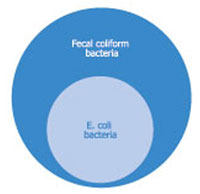
Fecal Coliform or E. coli?
The US EPA and State of Minnesota have established several standards for bacteria. Fecal coliform levels have been used for decades as the prime indicator, but the E. coli (Escherichia coli) level is now being phased in by most states at EPA's recommendation.
E. coli, a subgroup of fecal coliform bacteria, is also present in the intestinal tracts and feces of warm-blooded animals. Like fecal coliform, it is also used as an indicator of the potential presence of pathogens. Many water quality monitoring groups are using both indicators during the transition.
Minnesota River Basin Data Center | Minnesota State University, Mankato
184 Trafton Science Center S, Mankato, MN 56001 | Phone: (507)389-5492 | FAX: (507)389-5493
